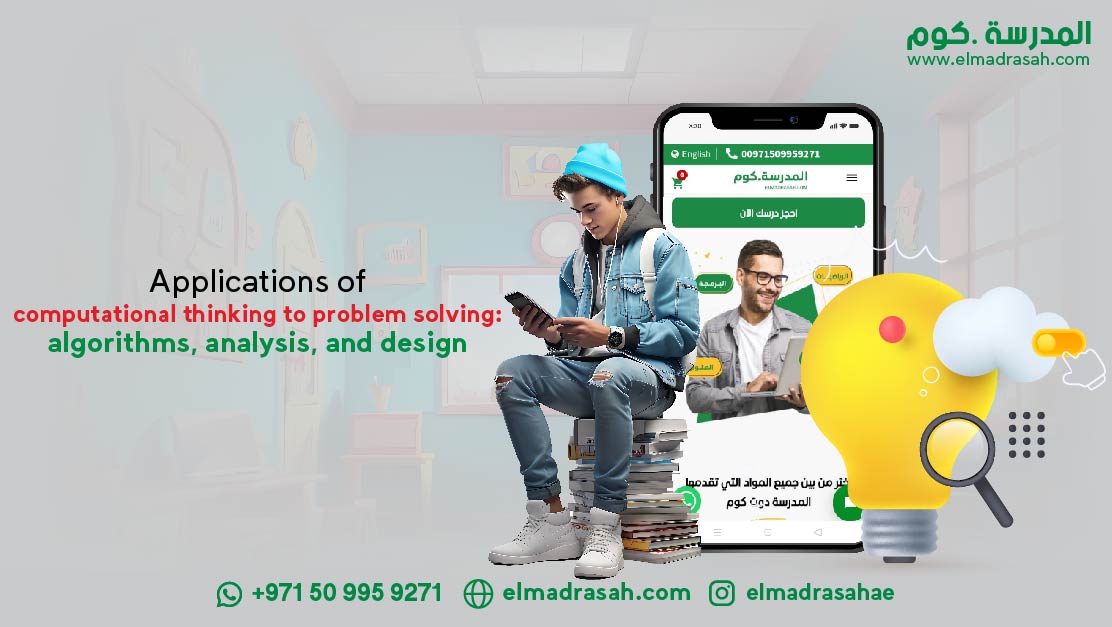
In the ever-evolving landscape of technology and education, the concept of computational thinking has gained significant prominence. Computational thinking involves the ability to formulate problems in a way that a computer can help solve them, and it encompasses a set of problem-solving skills and techniques that are vital in the digital age. This article explores the applications of computational thinking to problem solving, with a focus on algorithms, analysis, and design. Additionally, we will delve into the role of computational thinking in education, highlighting the significance of preparing for tests like the EmSAT Achieve Computer Science, specifically the Python version.
An Overview of Computational Thinking
Applications of computational thinking is a cognitive skill set that extends beyond the boundaries of computer science. It encapsulates a systematic approach to problem-solving that draws inspiration from the way computers process information. Let’s delve deeper into the core components of computational thinking and understand its broader applications.
1. Problem Decomposition:
At the heart of computational thinking lies the ability to break down complex problems into smaller, more manageable components. This involves dividing a problem into sub-problems or tasks, making it easier to analyze and solve each part independently. In real-world scenarios, this skill proves invaluable, as it enables individuals to tackle intricate challenges step by step.
2. Pattern Recognition:
Recognizing patterns is a fundamental aspect of computational thinking. It involves identifying recurring themes or structures within data or problems. This skill is akin to finding similarities in seemingly disparate information, allowing individuals to draw connections and make informed decisions. In everyday life, pattern recognition aids in predicting outcomes based on past experiences.
3. Abstraction:
Abstraction involves simplifying complex systems by focusing on the essential details while ignoring irrelevant information. In an overview of computational thinking, abstraction allows individuals to create models and representations that capture the core elements of a problem. This process facilitates a clearer understanding and efficient problem-solving. Outside the realm of computer science, abstraction is used in various fields to distill complex concepts into more digestible forms.
4. Algorithm Design:
Algorithms are step-by-step procedures or sets of instructions designed to perform specific tasks. Computational thinking emphasizes the creation and implementation of algorithms to solve problems. This skill extends to various disciplines, as algorithms are pervasive in fields such as mathematics, engineering, and even everyday tasks like cooking or organizing schedules. Crafting effective algorithms ensures efficiency and precision in problem-solving.
Broad Applications of Computational Thinking to Problem Solving:
a. Scientific Discovery:
Applications of computational thinking is increasingly vital in scientific research. Scientists use algorithms to analyze vast datasets, recognize patterns in experimental results, and model complex systems. This approach accelerates the pace of discovery in fields ranging from biology to physics.
b. Business and Economics:
In the business world, computational thinking is crucial for data-driven decision-making. Analyzing market trends, predicting consumer behavior, and optimizing business processes all rely on computational thinking principles. It provides a systematic framework for tackling intricate business challenges.
c. Education and Learning:
Integrating computational thinking into education goes beyond computer science courses. It fosters critical thinking, problem-solving, and creativity among students. Teachers can design lessons that encourage students to approach challenges systematically, preparing them for a rapidly evolving job market.
d. Everyday Problem Solving:
Applications of computational thinking is not reserved for specialized tasks—it is a mindset applicable to daily problem-solving. Whether troubleshooting a malfunctioning device, organizing tasks efficiently, or planning a project, individuals can leverage computational thinking to navigate various scenarios.
Embracing Computational Thinking in Education:
As educational institutions embrace the digital era, the incorporation of computational thinking into curricula becomes paramount. Platforms like Elmadrasah.com, with their EMSAT courses, play a crucial role in promoting computational thinking. These courses go beyond teaching specific content for standardized tests; they instill a problem-solving mindset that extends far beyond the realm of computer science.
Knowing the applications of computational thinking is a transformative skill that reaches into diverse aspects of our lives. Its systematic approach to problem-solving, abstraction, pattern recognition, and algorithm design positions individuals to navigate the complexities of the digital age successfully. As we continue to innovate and face new challenges, computational thinking will remain a cornerstone of effective problem-solving across various domains.
Computational Thinking in Education
Computational Thinking in Education: Nurturing Problem Solvers for the Digital Age
As the world becomes increasingly dependent on technology, the integration of computational thinking into education has become a pivotal aspect of preparing students for the challenges of the digital age. Computational thinking goes beyond coding; it encompasses a set of cognitive skills and problem-solving strategies that are applicable across various disciplines. Let’s delve deeper into the significance of computational thinking in education.
Fostering a Problem-Solving Mindset
At its core, computational thinking encourages students to approach problems with a structured and systematic mindset. By breaking down complex issues into smaller, more manageable components, students learn to analyze, understand patterns, and design step-by-step solutions. This approach not only enhances their problem-solving abilities but also cultivates a mindset that is adaptable to different challenges.
Cross-Disciplinary Applications
Computational thinking is not limited to computer science classes; its principles are applicable across disciplines. Whether in mathematics, science, humanities, or even the arts, students can leverage computational thinking to tackle problems in a logical and organized manner. This interdisciplinary applicability underscores the versatility of computational thinking as a fundamental skill set.
Preparation for the Workforce
In an era where technology is pervasive in the workplace, employers seek individuals with strong problem-solving skills. Computational thinking, with its emphasis on breaking down problems and designing efficient solutions, aligns with the demands of the modern workforce. Educators recognize that fostering computational thinking early on prepares students for a seamless transition into careers that require analytical thinking and innovative problem-solving.
Integrating Computational Thinking into Curricula
Educational institutions are increasingly incorporating computational thinking into their curricula, recognizing its long-term benefits for students. From elementary school to higher education, educators are designing lessons that emphasize logical reasoning, algorithmic design, and pattern recognition. These initiatives aim to equip students with skills that go beyond memorization, fostering a deeper understanding of concepts and their practical applications.
EmSAT Achieve Computer Science: A Standardized Measure
Tests like the EmSAT Achieve Computer Science play a crucial role in assessing students’ proficiency in computational thinking. The inclusion of sections such as Computer Science Theory and Problem Solving and Programming Practices reflects the recognition of the importance of both theoretical knowledge and practical problem-solving skills. As students prepare for such standardized tests, they not only enhance their chances of academic success but also develop a robust foundation in computational thinking.
Online Learning Platforms and Computational Thinking
Platforms like Elmadrasah.com are at the forefront of promoting computational thinking through specialized courses. These courses go beyond traditional teaching methods, incorporating interactive elements and real-world applications to reinforce computational thinking concepts. Online learning provides students with a flexible and accessible environment to enhance their skills, preparing them for the challenges posed by the EmSAT test and beyond.
Building Critical Thinkers for the Future
In essence, computational thinking in education is about nurturing critical thinkers and problem solvers who can navigate the complexities of the digital landscape. As technology continues to evolve, the ability to think computationally becomes a fundamental skill—one that empowers individuals to adapt to change, innovate, and contribute meaningfully to a technology-driven society.
The integration of computational thinking into education is a progressive step towards preparing students for the demands of the future. It is not just about mastering a specific programming language; it is about developing a mindset that thrives on logical reasoning, problem decomposition, and creative solution design. As educational institutions and online platforms continue to emphasize computational thinking, they pave the way for a generation of students who are not just consumers of technology but adept creators and problem solvers.
Elmadrasah.com EMSAT Courses and Connection to the Article
Elmadrasah.com plays a pivotal role in the context of the EmSAT Achieve Computer Science test, offering specialized courses that align with the test’s content areas and emphasize computational thinking. These courses are tailored to provide students with the knowledge and skills necessary to excel in both the theoretical and practical aspects of the test, ensuring a comprehensive preparation for the challenges posed by the evolving field of computer science.
Comprehensive Coverage of EmSAT Content Areas
Elmadrasah.com’s EMSAT courses go beyond traditional test preparation methods. They provide an in-depth exploration of the content areas outlined in the EmSAT Achieve Computer Science test, addressing key topics such as computing systems and networks, data analysis, impacts of computing, algorithms, and programming practices. Through a structured curriculum, students gain a deep understanding of these concepts, reinforcing their computational thinking abilities.
Hands-on Practice in Python Programming
Given that the EmSAT Achieve Computer Science test places a significant emphasis on programming practices, particularly in Python, Elmadrasah.com’s courses ensure that students are well-versed in this programming language. Python is renowned for its simplicity and readability, making it an ideal choice for introducing programming concepts. Elmadrasah.com’s courses guide students through the intricacies of Python programming, enabling them to confidently navigate the problem-solving challenges presented in the test.
Interactive Learning Environment
Elmadrasah.com distinguishes itself by offering an interactive and engaging learning environment. Through a combination of video lectures, interactive quizzes, and practical exercises, students have the opportunity to apply computational thinking in a hands-on manner. This interactive approach mirrors the problem-solving skills required in the EmSAT Achieve Computer Science test, fostering a deep understanding of the subject matter.
Emphasis on Computational Thinking
In line with the overarching theme of this article, Elmadrasah.com places a strong emphasis on developing computational thinking skills. The courses are designed to encourage students to approach problems systematically, break them down into manageable components, and design effective algorithms for solving them. This aligns seamlessly with the objectives of the EmSAT test, preparing students not only for exam success but also for real-world applications of computational thinking.
Preparation for Success in EmSAT Achieve Computer Science
Elmadrasah.com’s EMSAT courses aim to equip students not just with knowledge but with the problem-solving mindset necessary for success in the EmSAT Achieve Computer Science test. By connecting the theoretical concepts with practical applications and emphasizing the significance of computational thinking, Elmadrasah.com ensures that students are well-prepared to achieve high proficiency levels as per the EmSAT scoring descriptors.
The Role of Elmadrasah.com in Shaping Future Technologists
Beyond exam preparation, Elmadrasah.com plays a crucial role in shaping the future generation of technologists. By instilling a deep understanding of computational thinking and providing practical programming skills, the platform contributes to the development of a skilled workforce ready to meet the challenges of the digital era.
Elmadrasah.com’s EMSAT courses serve as a bridge between theoretical knowledge and practical application, aligning seamlessly with the applications of computational thinking to problem solving outlined in this article. By preparing students for the EmSAT Achieve Computer Science test, Elmadrasah.com contributes to the development of a generation well-equipped to navigate the complexities of the digital landscape.
Conclusion
In conclusion, the applications of computational thinking to problem solving, as exemplified in the EmSAT Achieve Computer Science test, underscore the importance of cultivating these skills in the educational landscape. By integrating computational thinking into curricula and leveraging specialized courses like those offered by Elmadrasah.com, students can not only excel in standardized tests but also develop a mindset that is invaluable in navigating the challenges of our increasingly digital world. As technology continues to advance, the ability to think computationally will undoubtedly remain a cornerstone of success in various fields.















